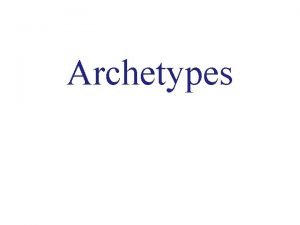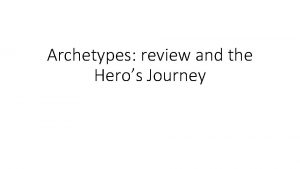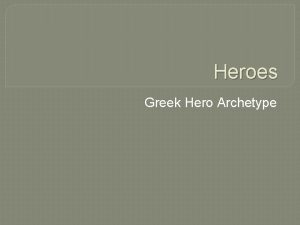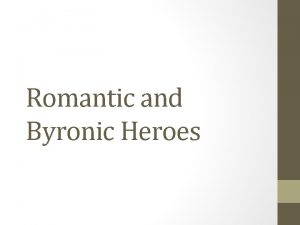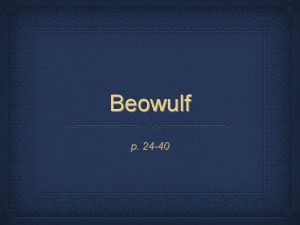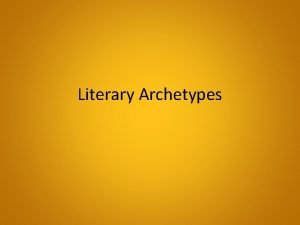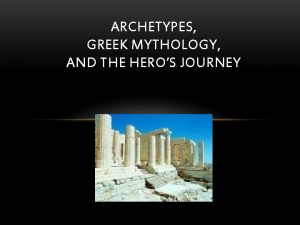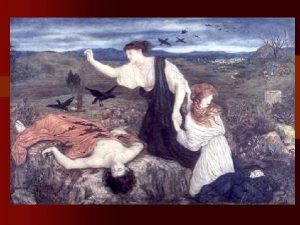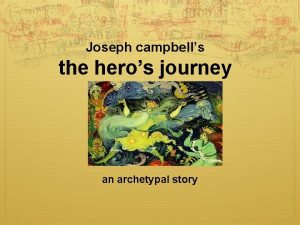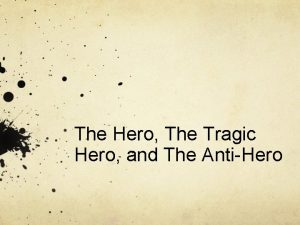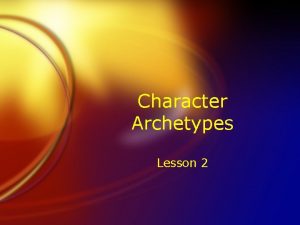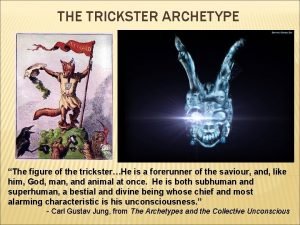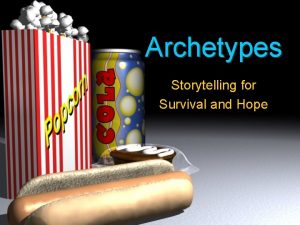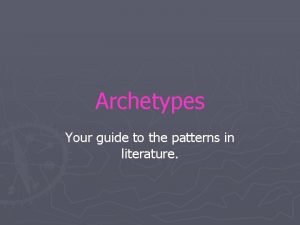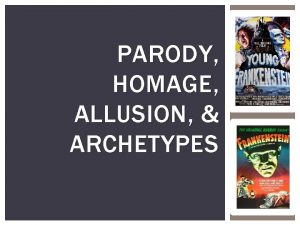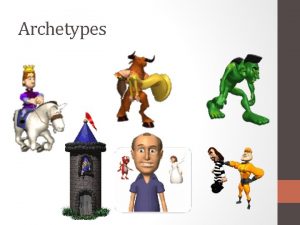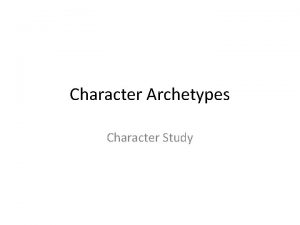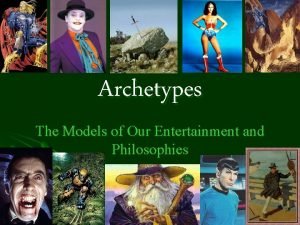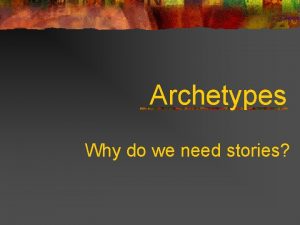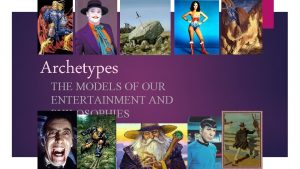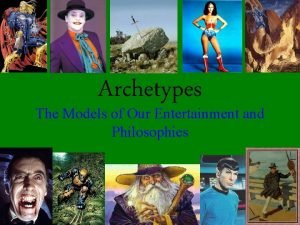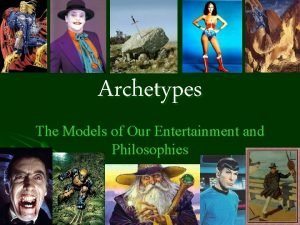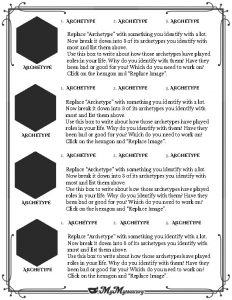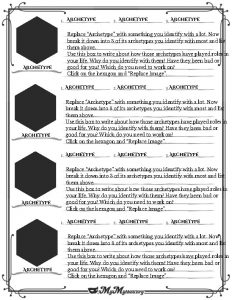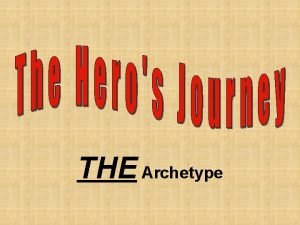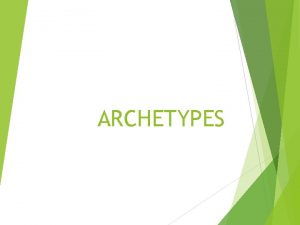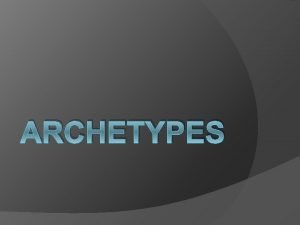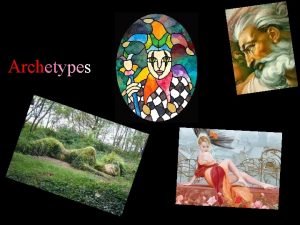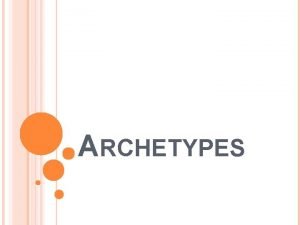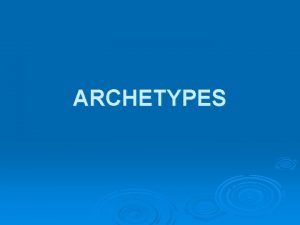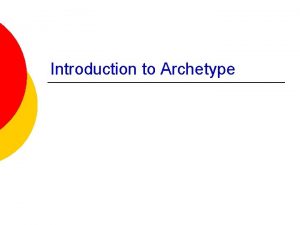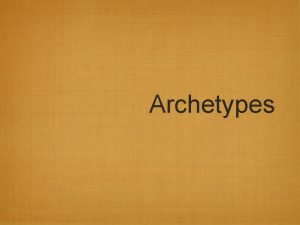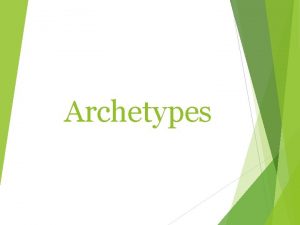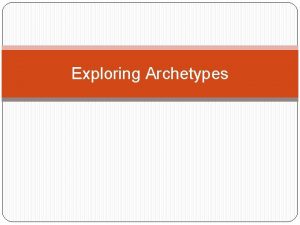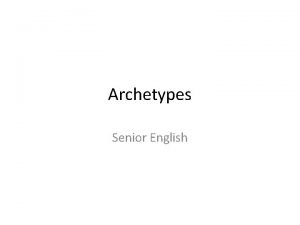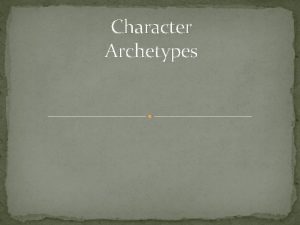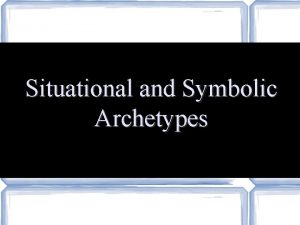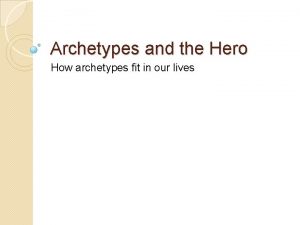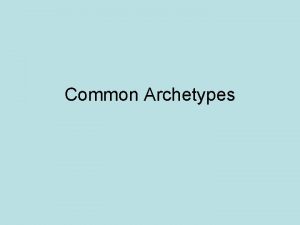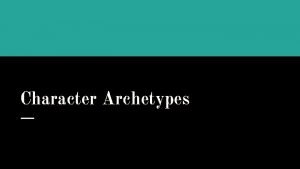Archetypes Character Archetypes The Hero Character Archetype The
































- Slides: 32

Archetypes

Character Archetypes

The Hero Character Archetype • The one who may fulfill a necessary task and who will restore fertility, harmony, and/or justice to a community. • The hero is the one who typically experiences an initiation, and who does the community's ritual. Often he/she will embody characteristics of YOUNG PERSON FROM THE PROVINCES, INITIATE, INNATE WISDOM, PUPIL, and SON.

Young Person From the Provinces Character Archetype • This hero is taken away as an infant or youth and raised by strangers. • Later returns home as a stranger and is able to recognize new problems and solutions afterwards.

The Initiates Character Archetype • Young heroes who, prior to the quest, must endure some training and ritual • They are usually innocent at this stage.

Mentors Character Archetype • Serve as teachers or counselors to the initiates • Sometimes act as role models or father/mother figure • Teach by example the skills necessary to survive the journey and quest

Loyal Retainers Character Archetypes • The noble sidekicks to the hero • Their duty is to protect the hero. • Often they reflects the hero’s nobility.

Friendly Beasts Character Archetypes • Assist the hero and reflect that nature is on the hero’s side

The Devil Figure Character Archetypes • Represents evil incarnate • May offer worldly goods, fame, or knowledge to the protagonist (hero) in exchange for possession of the soul or integrity • Main aim is to oppose the hero on his quest

The Temptress Character Archetype • Characterized by sensuous beauty • Her physical attraction may distract the hero and bring about the his downfall.

The Platonic Ideal Character Archetype • Often a spiritual source of inspiration • Someone for whom the hero has an intellectual or emotional rather than physical attraction

Damsel in Distress Character Archetype • Vulnerable woman who must be rescued by the hero • May also be used as a trap, by an evil figure, to ensnare the hero

The Star-Crossed Lovers Character Archetype • Two characters engaged in a love affair that is fated to end in tragedy for one or both due to the disapproval of society, friends, family, or the gods

The Creature of Nightmare Character Archetype • This monster, physical or abstract, is summoned from the deepest, darkest parts of the human psyche to threaten the lives of the hero/heroine. Often it is a perversion or desecration of the human body.

Situation Archetypes

The Quest Situation Archetype • This motif describes the search for someone or some talisman which, when found and brought back, will restore fertility to a wasted land, the desolation of which is mirrored by a leader’s illness and disability.

The Task Situation Archetype • The superhuman accomplishment that is necessary in order to fulfill the ultimate goal • There may be many tasks within a quest.

The Journey Situation Archetype • This sends the hero in search for some truth of information necessary to restore fertility, and/or harmony to the kingdom. • The journey includes the series of trials and tribulations the hero faces along the way. Usually the hero descends into a real or psychological hell and is forced to discover the blackest truths, quite often concerning his faults. • Once the hero is at this lowest level, he must accept personal responsibility to return to the world of the living.

The Initiation Situation Archetype • A moment, usually psychological, where an individual comes into maturity • Gains a new awareness of situations/problems and understands the responsibility for trying to resolve the dilemma • Typically, the hero receives a “calling”, (message or signal) that they must make sacrifices to take control of the situation. • Often a hero will deny and question this calling, but will eventually accept responsibility.

The Ritual Situation Archetypes • Not to be confused with the Initiation. • The Ritual refers to an organized ceremony which involves honored members of a given community and an Initiate. • This situation officially brings the young man or woman into the realm of the community's adult world.

The Fall Situation Archetype • Not to be confused with the awareness in The Initiation, this archetype describes a descent in action from a higher to a lower state of being, an experience that might involve defilement, moral imperfection, and/or loss of innocence. • This fall is often accompanied by expulsion from a kind of paradise as penalty for disobedience and/or moral transgression.

Death and Rebirth Situation Archetypes • The most common of all situational archetypes, this motif grows out of the parallel between the cycle of nature and the cycle of life. • This fall is often accompanied by some sign of birth or rebirth

Battle Between Good and Evil Situation Archetype • Puts obvious forces which represent good and evil against one another • Typically, good ultimately triumphs over evil despite great odds.

The Unhealable Wound Situation Archetype • This wound, physical or psychological, cannot be healed fully. • Indicates a loss of purity or innocence • Often drives the sufferer to desperate measures of madness.

The Magic Weapon Situational Archetype • A skilled individual hero’s ability to use a piece of technology to combat evil, continue a journey, or to prove his/herself as a chosen individual • (Sometimes connected with the Task)

Symbolic Archetypes

Light vs. Darkness Symbolic Archetype • Light suggests hope, renewal, or intellectual illumination. • Darkness implies the unknown, ignorance, or despair.

Water vs. Desert Symbolic Archetype • Because water is needed for life and growth, it commonly appears as a birth or rebirth symbol. • Water is used in baptism services (spiritual births). • Rain in a work of literature can suggest a character’s spiritual birth. • Desert implies ignorance, darkness, sterility and death.

Heaven vs. Hell Symbolic Archetype • Humanity has traditionally associated non -accessible parts of the universe with the dwelling places of the supernatural. • The skies and mountaintops house its gods; the bowels of the earth contain the evil forces that inhabit its universe.

Haven vs. Wilderness Symbolic Archetype • Haven is a place of safety. • The wilderness/forests symbolize danger or the unknown. • Heroes are often sheltered for a time to regain health and resources.

Fire vs. Ice Situational Archetype • Fire represents knowledge, light, life and rebirth. • Ice like desert represents ignorance, darkness, sterility and death.

Supernatural Intervention Symbolic Archetype • The gods can either intervene on the side of the hero or against him.
 Ice archetype
Ice archetype Hero s journey character archetypes
Hero s journey character archetypes The hero's journey character archetypes 101
The hero's journey character archetypes 101 Greek hero archetype
Greek hero archetype The archetypal hero
The archetypal hero The byronic hero
The byronic hero Beowulf hero archetype
Beowulf hero archetype Round facer kenning
Round facer kenning Elements of romanticism in the devil and tom walker
Elements of romanticism in the devil and tom walker Hero archetype traits
Hero archetype traits Romantic hero archetype
Romantic hero archetype Archetype definition greek mythology
Archetype definition greek mythology Who is a tragic hero
Who is a tragic hero Joseph campbell hero archetype
Joseph campbell hero archetype Tragic hero vs anti hero
Tragic hero vs anti hero Character archetypes smash ultimate
Character archetypes smash ultimate Simon archetype lord of the flies
Simon archetype lord of the flies Define trickster archetype
Define trickster archetype Archetypes storytelling
Archetypes storytelling Archetypal pattern meaning
Archetypal pattern meaning Horror movie character archetypes
Horror movie character archetypes Archetypal colors
Archetypal colors Villain character archetypes
Villain character archetypes Himedere definition
Himedere definition Maiden archetype examples
Maiden archetype examples Haven vs wilderness examples
Haven vs wilderness examples Innate wisdom vs. educated stupidity
Innate wisdom vs. educated stupidity Unfaithful wife archetype examples
Unfaithful wife archetype examples The green character archetype
The green character archetype Trickster archetypes
Trickster archetypes Innate wisdom vs educated stupidity archetype
Innate wisdom vs educated stupidity archetype Thiếu nhi thế giới liên hoan
Thiếu nhi thế giới liên hoan Phối cảnh
Phối cảnh
